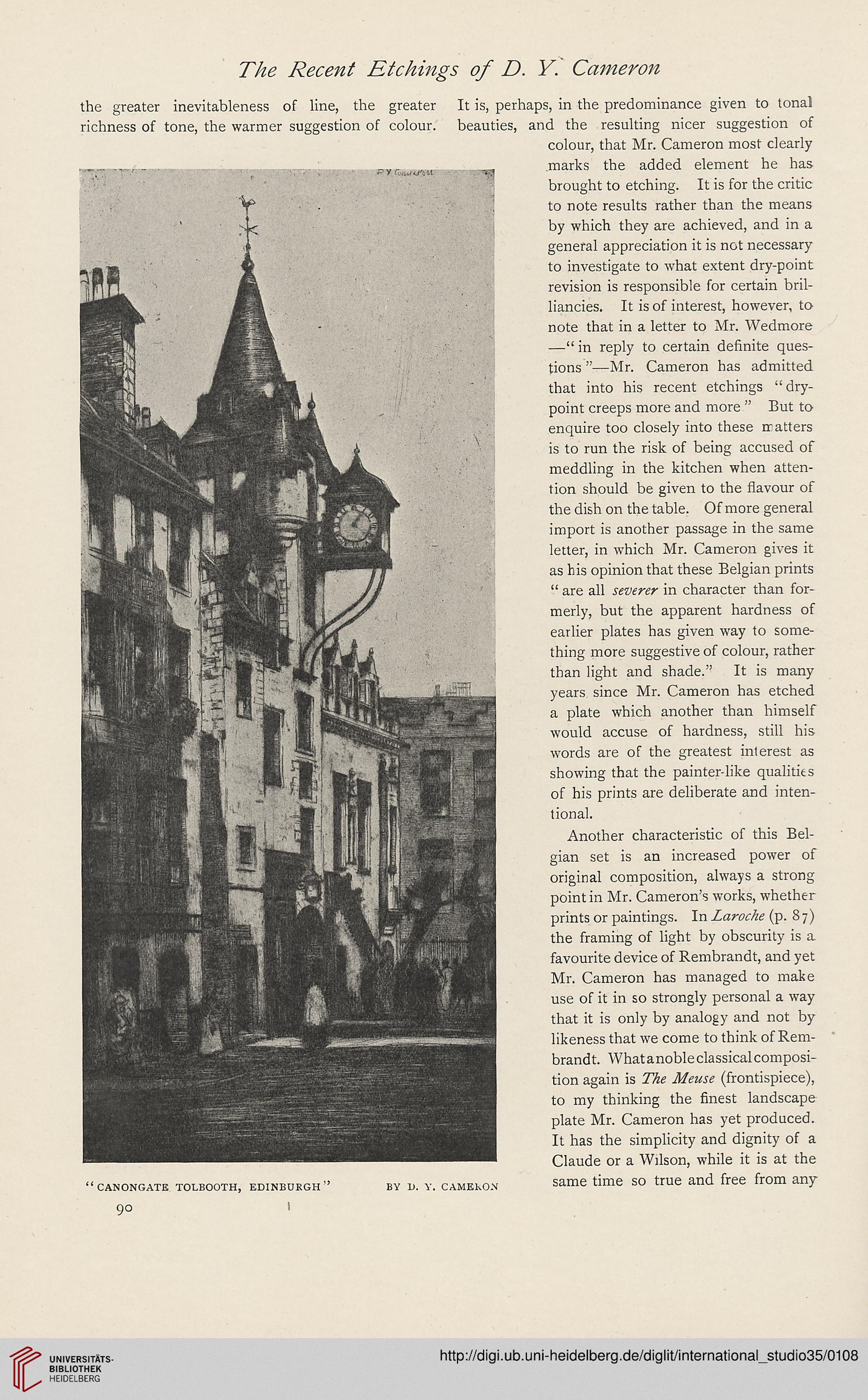The Recent Etchings of D. Y. Cameron
the greater inevitableness of line, the greater
richness of tone, the warmer suggestion of colour.
“CANONGATE. TOLBOOTH, EDINBURGH ”
90
It is, perhaps, in the predominance given to tonal
beauties, and the resulting nicer suggestion of
colour, that Mr. Cameron most clearly
.marks the added element he has
brought to etching. It is for the critic
to note results rather than the means
by which they are achieved, and in a
general appreciation it is not necessary
to investigate to what extent dry-point
revision is responsible for certain bril-
liancies. It is of interest, however, to
note that in a letter to Mr. Wedmore
—“ in reply to certain definite ques-
tions ”—Mr. Cameron has admitted
that into his recent etchings “ dry-
point creeps more and more ” But to
enquire too closely into these matters
is to run the risk of being accused of
meddling in the kitchen when atten-
tion should be given to the flavour of
the dish on the table. Of more general
import is another passage in the same
letter, in which Mr. Cameron gives it
as his opinion that these Belgian prints
“ are all severer in character than for-
merly, but the apparent hardness of
earlier plates has given way to some-
thing more suggestive of colour, rather
than light and shade.” It is many
years since Mr. Cameron has etched
a plate which another than himself
would accuse of hardness, still his
words are of the greatest interest as
showing that the painter-like qualities
of his prints are deliberate and inten-
tional.
Another characteristic of this Bel-
gian set is an increased power of
original composition, always a strong
point in Mr. Cameron’s works, whether
prints or paintings. In Laroche (p. 87)
the framing of light by obscurity is a
favourite device of Rembrandt, and yet
Mr. Cameron has managed to make
use of it in so strongly personal a way
that it is only by analogy and not by
likeness that we come to think of Rem-
brandt. What anoble classical composi-
tion again is The Meuse (frontispiece),
to my thinking the finest landscape
plate Mr. Cameron has yet produced.
It has the simplicity and dignity of a
Claude or a Wilson, while it is at the
by d. v. camekon same time so true and free from any
the greater inevitableness of line, the greater
richness of tone, the warmer suggestion of colour.
“CANONGATE. TOLBOOTH, EDINBURGH ”
90
It is, perhaps, in the predominance given to tonal
beauties, and the resulting nicer suggestion of
colour, that Mr. Cameron most clearly
.marks the added element he has
brought to etching. It is for the critic
to note results rather than the means
by which they are achieved, and in a
general appreciation it is not necessary
to investigate to what extent dry-point
revision is responsible for certain bril-
liancies. It is of interest, however, to
note that in a letter to Mr. Wedmore
—“ in reply to certain definite ques-
tions ”—Mr. Cameron has admitted
that into his recent etchings “ dry-
point creeps more and more ” But to
enquire too closely into these matters
is to run the risk of being accused of
meddling in the kitchen when atten-
tion should be given to the flavour of
the dish on the table. Of more general
import is another passage in the same
letter, in which Mr. Cameron gives it
as his opinion that these Belgian prints
“ are all severer in character than for-
merly, but the apparent hardness of
earlier plates has given way to some-
thing more suggestive of colour, rather
than light and shade.” It is many
years since Mr. Cameron has etched
a plate which another than himself
would accuse of hardness, still his
words are of the greatest interest as
showing that the painter-like qualities
of his prints are deliberate and inten-
tional.
Another characteristic of this Bel-
gian set is an increased power of
original composition, always a strong
point in Mr. Cameron’s works, whether
prints or paintings. In Laroche (p. 87)
the framing of light by obscurity is a
favourite device of Rembrandt, and yet
Mr. Cameron has managed to make
use of it in so strongly personal a way
that it is only by analogy and not by
likeness that we come to think of Rem-
brandt. What anoble classical composi-
tion again is The Meuse (frontispiece),
to my thinking the finest landscape
plate Mr. Cameron has yet produced.
It has the simplicity and dignity of a
Claude or a Wilson, while it is at the
by d. v. camekon same time so true and free from any




